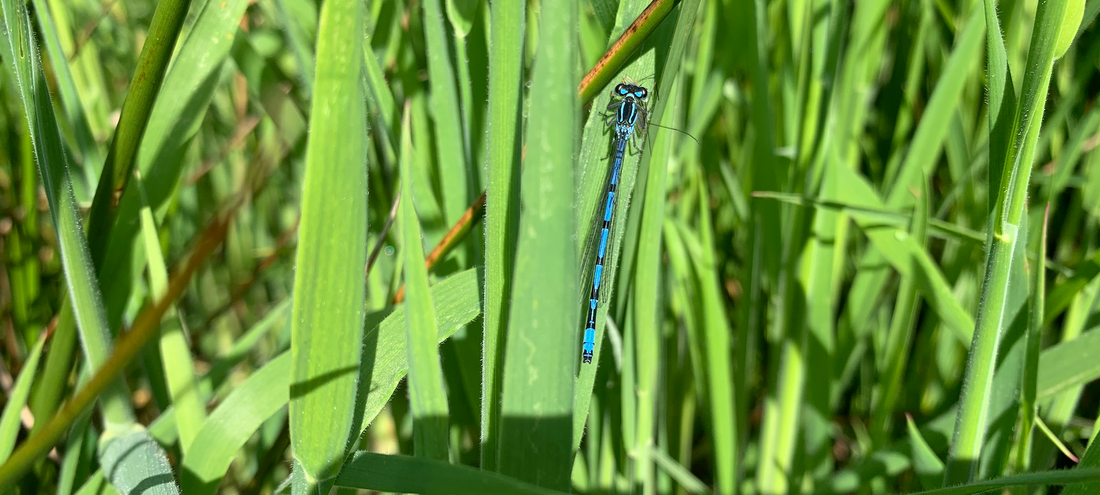Nature's intricate tapestry often presents us with captivating wonders, such as the enchanting world of dragonflies and damselflies. These delicate creatures, with their gossamer wings and graceful flight, can be found near ponds and water bodies. Pictured above is one of the thousands of slender blue, what I assumed were dragonflies, that flit around the pond field at this time of year. It's June, in case you're reading this in the future - hello person from the future! I did some research and discovered that they are in fact damselflies. So, I decided to do a deep dive into the remarkable distinction between dragonflies and damselflies, exploring their characteristics, habitats, and the damselflies' life cycle.
Dragonflies and damselflies: a comparative overview
Dragonflies and damselflies both belong to the order Odonata, but they differ in several key aspects. Understanding these differences will help you identify and appreciate their unique traits. While both insects are known for their ability to hover, fly with agility, and capture prey mid-air, there are distinct features that set them apart.
Body Shape and Posture:
- One of the primary distinctions lies in their body shape and posture. Dragonflies have robust bodies and a noticeably broader appearance. When at rest, they hold their wings outstretched horizontally, resembling miniature aeroplanes or helicopters. In contrast, damselflies have a more slender, delicate physique. They fold their wings vertically above their bodies, creating a narrow silhouette.
Wing Shape and Veins:
- The wings of dragonflies and damselflies also exhibit distinct characteristics. Dragonfly wings are broad, transparent, and slightly shorter than their bodies. They possess a complex network of veins that often appear visibly thick and intricate. On the other hand, damselfly wings are narrower and elongated. Their veins are generally thinner and less pronounced.
Eye Placement and Shape:
- Another fascinating aspect to observe is the positioning and shape of their eyes. Dragonflies have eyes that are set wide apart on their heads, providing a near-360-degree field of vision. Their eyes are typically large, spherical, and often brightly coloured. In contrast, damselflies' eyes are relatively smaller and situated closer together on their heads. They usually have an oval shape, offering a more forward-focused vision.
The lifecycle of damselflies
Now, let's dive into the mesmerising lifecycle of damselflies, which I've had the privilege to witness firsthand in the pond.
Egg Stage:
- The life cycle of damselflies begins when females deposit their eggs near or in aquatic vegetation. These eggs are often attached to plants or submerged objects. The eggs incubate and develop underwater, protected from potential predators.
Larval Stage:
- From the eggs hatch nymphs, also known as larvae. The nymphs are aquatic creatures and spend their time hidden among vegetation or debris in the water. They undergo a series of moults as they grow, shedding their exoskeletons to accommodate their increasing size. Damselfly nymphs are recognisable by their elongated bodies, six legs, and external gills located at the end of their abdomen.
Emergence:
- After several moults, the nymphs undergo a remarkable transformation known as emergence. They climb out of the water onto a sturdy stem or leaf, where their exoskeleton splits open, and the adult damselfly emerges. This process can be observed as the exuviae (the shed exoskeleton) remains attached to the plant, serving as a testament to the damselfly's metamorphosis.
Adult Stage:
- As the newly emerged damselfly's wings expand and dry, it undergoes a dramatic physical change. The dull colours of the nymph transform into vibrant hues, revealing their adult form. Once their wings are fully functional, they take flight, joining their fellow damselflies in search of mates and establishing territories near water sources.
And there we have it, the reason my neighbours think I've lost my mind. I love following them around, watching how they interact with the world and each other. Capturing them on video is extremely difficult as they are so slender and insanely quick. You've just got to put the phone away and take a minute to enjoy their show in real life.

